And lo, a car company was born, because until this point no factory nor business existed.
Since then we’ve seen monumental changes, both in the motor industry and on the world stage writ large. But the Renault company is still very much alive and kicking.
Here’s a potted decade-by-decade account of its trials and tribulations, illustrated with images taken at Renault’s 750-strong collection of significant cars from its history. This heritage fleet is stored and lovingly maintained at the firm’s Flins factory to the west of Paris, where the current Clio and Zoe superminis are assembled, and CAR got access to tell the story…
Decade 1: 1898-1908
Following the Type A, Renault leapt into car manufacturing with gusto, honing designs for vehicles aimed primarily at his wealthy group of friends and associated. For that reason they were posh, well-appointed and expensive, or aimed squarely at the burgeoning world of motorsport – or both.
But it was during this period that a highly significant Renault was launched. Louis’ company won the first contract to supply taxis to Paris, starting with a production run of 500 units in 1905.
The Type AG 8 CV – which gained the moniker Taxi de la Marne during WWI – meant that for the first time the French public didn’t need to own a car themselves to get around, opening up motoring to the masses. It also served to familiarise the population of Paris with the idea of the motorcar.

Decade 2: 1908-1918
This period was understandably dominated by WWI, which was declared on 1 August 1914. Car production in France fell dramatically as companies were seconded into the war effort, and Renault’s contribution was the FT tank – the first to have its armament in a fully rotating turret, and the first to employ the crew at the front, engine in the back layout that is still used in tanks today.
By the end of the war in 1918, Renault’s workforce has grown from 4400 to 22,000 people.
Decade 3: 1918-1928
Optimism, wealth and exploration. This was a heady time of lavishly appointed cars – one of which, the Type 40 CV, sporting the first diamond Renault badge ever, designed to coordinate with the art deco styling of the era. This was a theme that prevailed through many of Renault’s subsequent models.
It was also during this era that Renault built the Type MH, paving the way for French colonial expeditions through the Sahara desert and securing the firm’s position as an international car company. Louis Renault’s vision was to blaze a trail through Africa developing tourism in his wake.
At the end of this decade Renault’s company had 29,500 workers, and was starting to feel the effects of socialism – first with the first Communist Party cell at the factory in 1924 and then in May 1928 workers went on strike for a 10% pay increase. This was the second attempt, though: Renault had previously sacked many employees for strike action in 1926…
Decade 4: 1928-1938
Things didn’t get off to a great start. During 1929-30 the Great Depression had a crippling impact on big industry worldwide. It forced Renault to lay off some of its workforce and to start thinking more cleverly about the sorts of cars the public needed.
The resulting ethos was one of paring back: employee numbers dropped to a low of 22,000 in 1932 and at the same time Renault started building the relatively lightweight, lower-cost models alongside the far larger, more luxurious vehicles the company made its name building for the upper class.
The Juvaquatre you can see above has four seats, weighs just 750kg and had a far lower build cost. Models like this signalled a change in direction for Renault’s target demographic. Cars were weaving their way into mainstream family life, and to beat the Depression it was crucial to transform into a carmaker for the masses.
Decade 5: 1938-1948
You don’t need to be a doctor of world history to know that WW2 happened in this era. Production of all civilian cars ceased and the Renault factories were ‘occupied’ by a certain Daimler-Benz’s management team in 1940…
The company was forced to build vehicles to help with the war effort, but in the background engineers were working on a design for a car for post-war Europe. Again it was to be incredibly lightweight, simple, with four seats, a rear-mounted engine and a price tag accessible to the general public.
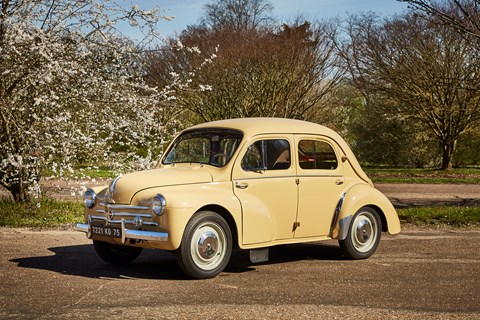
Project 106E was to become perhaps the most significant Renault of all time: the 4CV. This loveable small car had front suicide doors and is widely credited with being the ‘French Beetle’, and indeed, the Beetle’s creator Ferdinand Porsche worked at the Flins factory for a short consultation stint, contributing to the project but ultimately with reluctance without his own engineering team to call upon.
The 4CV eventually sold over a million units worldwide, helping Renault become the largest automobile manufacturer in Europe. In 1945 the company was nationalised by the French government after WW2 and the death (rumoured to be in suspicious circumstances) of Louis Renault.
Decade 6: 1948-1958
During this period the 4CV enabled Renault to accelerate development of its mass-production methods, and a number of off-shoot vehicles emerged using the same platform layout or design language.
The vehicle below is a 1952 Colorale, which was offered either as a pickup or seven-seater, but the front end is styled to look like the 4CV. An early example of a ‘family face’…
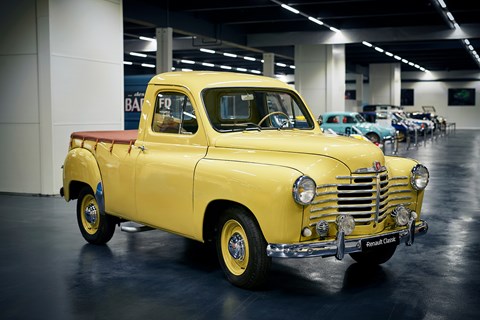
It was eventually replaced in 1956 by the slightly more upmarket Dauphine, which was more popular still, selling more than two million units in its 11-year production spell.
A low-cost performance model was launched, tuned by Italian racer Amedee Gordini and badged accordingly. This was the first time a Renault used this moniker, and the car had more power from its 845cc motor – up from 27bhp to a heady 36bhp – and a four-speed manual gearbox in place of the three-ratio in the standard car.
The Dauphine saw much success in motorsport. There was a dedicated racing version called the 1093, and victories at Monte-Carlo, Le Mans and the Mille Miglia were among its scalps along the way.
Decade 7: 1958-1968
Development of the concept of maximising interior space led Renault’s designers towards a one-space cabin design incorporating the boot rather than the more conventional three-box design many were familiar with. Several concepts explored this idea in varying configurations.
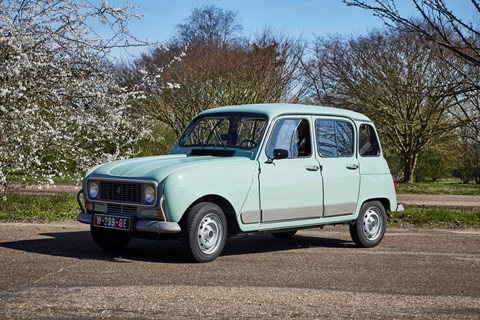
The result was the Renault 4 – the first mass-production Renault hatchback, with a folding rear bench for added practicality. It was front-engined and front-wheel drive, unlike its predecessors, and was slated as the ‘blue jeans car’. A car for everyone.
As a foil for the blue-collar nature of the cheap-and-cheerful 4, Renault continued to build cars for executive-grade motorists. The Renault 16 was its embodiment in this period, launched in 1965.
Decade 8: 1968-1978
It wasn’t until 1972 that the 4’s replacement, and the next important Renault, surfaced: the 5. It was billed as a car for young people; its design was meant to be fun, with no sharp lines and a softer style. The fact that there were no rear doors or opening windows was billed as a safety feature, because in the event of an accident there wouldn’t be broken glass in the rear, where your kids were meant to sit.

Its boot was meant to be as big as a shopping trolley, but more importantly, the 5 was developed to within an inch of its life for various motorsport disciplines. Its crowning glory was the mid-engined, rear-driven Maxi Turbo 2 above, which was hugely successful in rallying until four-wheel drive Group B cars came along to spoil the fun.
Decade 9: 1978-1988
But Renault nowadays isn’t just known for performance models. The idea of maximising interior space with clever engineering manifested itself perfectly in the Espace MPV, launched in 1984.
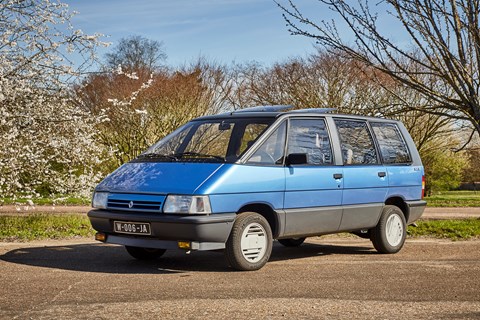
A joint venture with Matra, it had a flat floor, a massive glasshouse, a rear hatch (like the 4 and 5 above), swivelling seats, folding picnic tables and an incredibly eighties dash design that has dated terribly.
Decade 9: 1988-1998
Renault’s involvement in motorsport arguably started way back in 1898 with that challenge Louis Renault undertook in Paris, but there hasn’t been a more prominent era for La Regie on the international racing stage than this. It cemented the diamond badge’s place in top-flight competition.
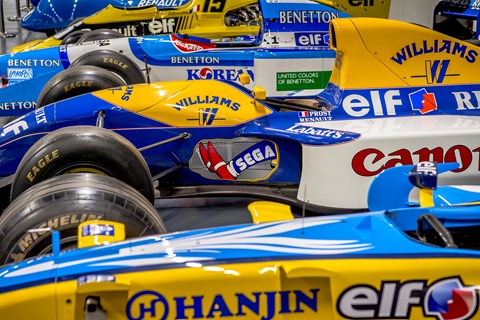
Renault-badged F1 cars won the constructors’ World Championship six times on the bounce between 1992 and 1998, when the company announced its official retirement from the sport. Successful drivers included Alain Prost, Nigel Mansell, Jacques Villeneuve, Damon Hill, Michael Schumacher and of course Ayrton Senna.
Decade 10: 1998-2008
The most significant event in this era was Renault’s marriage with Nissan to form the alliance we know today.
Car designs had moved on considerably, and nowhere is this better demonstrated than with the Renault Scenic – the ‘Megane’ part of its name dropped during its 1999 mid-life facelift.
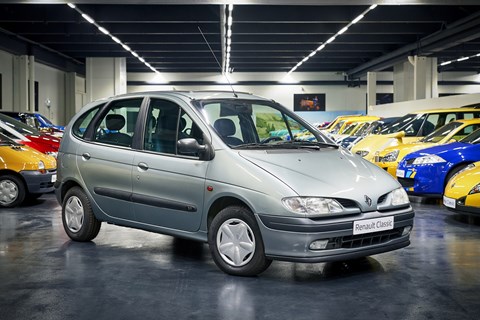
This practical, cleverly designed family car proved incredibly popular for Renault – more so than it was really prepared for. A European Car of the Year win early in its lifecycle helped, but even so at one point the firm’s Douai plant was pumping out cars at a rate of 2,500 a day. They’d expected demand to be under 500…
Decade 11: 2008-2018
The most recent period in Renault’s history and the motoring landscape is changing. Car firms are scrambling to launch cleaner and more efficient vehicles, and the alliance with Nissan allowed Renault to capitalise on this by taking technology developed in the Leaf and installing it in the Clio platform to create the Zoe BEV.

Until this point there hadn’t been a normal-looking pure-electric car for those who don’t want to stand out. It’s an indication that the sands are shifting as EVs move towards the mainstream.
Decade 12: 2018-on
What’s next for Renault? We’re expecting a new Clio in 2019 and the long-awaited Alpine A110 project will hit roads before 2018 is out, but it’s the company’s electrification strategy and development of autonomous technology that’s likely to play the biggest role. Oh, and Mitsubishi’s joining the Renault-Nissan party too, so we can expect platform-sharing abound.
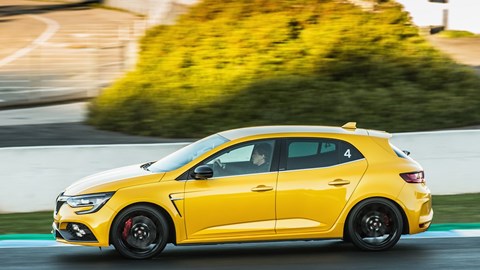
Just as long as it continues building hot hatches for those who love to drive – like the current and most excellent Megane R.S. – then we reckon things will be OK.